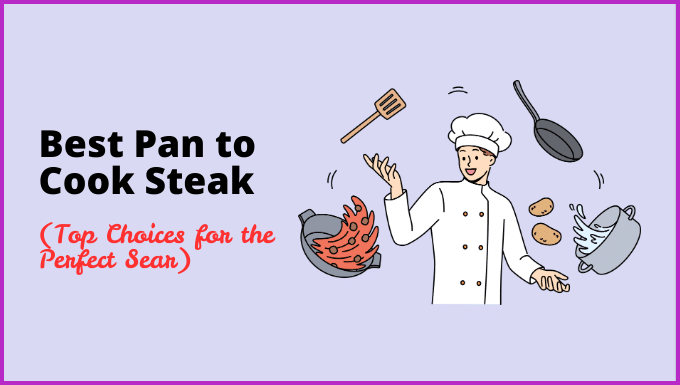I still remember the first time I tried cooking a steak at home. I was so excited—I had a beautiful cut of meat, my seasonings ready, and I thought I was all set. But when I placed the steak in the pan, things didn’t go as planned. The meat stuck to the surface, the sear was uneven, and instead of that mouthwatering golden-brown crust, I ended up with a sad-looking piece of beef. That’s when I realized how important it is to use the best pan to cook steak.
The right pan makes all the difference. It helps you get that rich, caramelized crust while keeping the inside tender and juicy. But with so many options—cast iron, stainless steel, carbon steel, and even non-stick—it can be overwhelming to choose the best one. In this guide, I’ll share my personal experience with different types of pans, what works best, and how you can achieve restaurant-quality steak at home.
If you’re also looking for the best way to season steak, check out my steak seasoning guide to make sure your flavors are on point before you start cooking. Now, let’s dive in and find out which pan will give you the perfect steak every time!

Why the Right Pan Matters for Cooking Steak
I still remember the first time I tried to cook a steak at home—I had all the ingredients ready, my steak was beautifully marbled, and I was excited to get that perfect restaurant-style sear. But there was one big problem: I was using the wrong pan. The result? A sad, unevenly cooked steak that lacked the crispy crust I was hoping for.
That experience taught me a crucial lesson: choosing the best pan to cook steak makes all the difference. A good pan ensures even heat distribution, helps develop a rich, golden-brown crust, and prevents sticking. On the other hand, the wrong pan can leave you with an underwhelming, chewy steak.
1. Heat Retention is Key for a Perfect Sear
Steak needs high heat to develop that delicious caramelized crust (also called the Maillard reaction). If your pan doesn’t retain heat well, the temperature will drop as soon as you place the steak in it. This leads to a pale, grayish steak instead of the deep brown crust you see in steakhouses.
Best Choice: Cast iron and stainless steel pans are excellent at holding heat, making them ideal for steak cooking.
2. Even Heat Distribution Prevents Uneven Cooking
Have you ever cooked a steak that was perfect on one side but barely browned on the other? That happens when your pan doesn’t distribute heat evenly. Some pans create hot spots, meaning parts of the steak cook faster than others. This is a common issue with thin, low-quality pans.
Best Choice: A heavy-bottomed pan (like a cast iron skillet or carbon steel pan) ensures even cooking, giving you that perfect edge-to-edge doneness.
3. Non-Stick vs. Traditional Pans – Which One is Better?
A lot of beginners wonder if a non-stick pan is the best pan to cook steak. While non-stick pans are great for delicate foods like eggs and fish, they aren’t the best choice for steak. They can’t handle the high heat required for a good sear, and over time, high temperatures can damage the coating.
Best Choice: Stick with cast iron, stainless steel, or carbon steel for the best results. If you’re new to cast iron, check out my guide on how to season a cast iron skillet to keep it in top condition.
4. The Right Pan Makes Cleanup Easier
Steak can leave behind bits of caramelized meat and fat, which can be tough to clean—especially if the pan isn’t suited for high-heat cooking. A properly seasoned cast iron skillet or a well-maintained stainless steel pan allows for easy cleanup. Plus, you can use those flavorful bits to make a delicious pan sauce!
Pro Tip: Deglaze your pan with a bit of broth, wine, or butter after cooking to lift off those tasty browned bits and make an easy sauce. You can find more on this in my easy pan sauce recipe.
If you want to cook steak like a pro, the pan you choose is just as important as the cut of meat. A good cast iron, stainless steel, or carbon steel pan will help you achieve that mouthwatering sear and even cooking. So, next time you’re getting ready to cook a steak, make sure you have the right pan—you’ll taste the difference!
Up next, let’s dive into the best pans for cooking steak and how each one compares.
Best Types of Pans for Cooking Steak
When I first started cooking steak at home, I quickly realized that the pan I used made a huge difference. At first, I tried using a regular non-stick pan because that’s what I had, but my steak never got that rich, crispy sear I craved. After some trial and error (and a few overcooked steaks), I found the best pans for cooking steak. Here’s what I learned from experience.
1. Cast Iron Skillet – The Ultimate Steak Pan
If you ask any steak lover about the best pan to cook steak, chances are they’ll recommend a cast iron skillet—and for good reason. I still remember the first time I used a cast iron pan for steak. The difference was night and day! The pan held onto heat like a champ, giving my steak that perfect golden-brown crust.
Why Cast Iron Is Great for Steak:
✔️ Superior heat retention – Once it’s hot, it stays hot, ensuring an even sear.
✔️ Naturally non-stick (when seasoned properly) – The more you use it, the better it gets.
✔️ Oven-safe – Perfect for finishing steak in the oven after searing.
Personal Tip:
Preheat the cast iron pan for at least 5 minutes before adding the steak. This ensures a proper sear instead of steaming the meat. Also, seasoning your cast iron regularly will keep it in top shape.
If you’re serious about steak, I highly recommend investing in a good cast iron skillet. It lasts a lifetime if taken care of properly.
👉 Looking for ways to season your steak? Check out my guide on The Best Steak Seasoning Guide.
2. Stainless Steel Pan – Ideal for a Restaurant-Quality Sear
Before I discovered cast iron, I tried cooking steak in a stainless steel pan. At first, I struggled with sticking issues, but once I learned the right technique, I started getting amazing results.
Why Stainless Steel Works Well for Steak:
✔️ Creates an excellent sear – Great for that golden-brown crust.
✔️ Heats evenly – No hot or cold spots.
✔️ Perfect for making pan sauces – After searing, you can deglaze with wine or broth for extra flavor.
Personal Tip:
The key to using stainless steel is preheating and oiling properly. If you add the steak too soon, it will stick. A good trick is to sprinkle a few water droplets in the pan—if they dance around and disappear quickly, it’s ready for the steak.
👉 Want to learn the best steak cooking techniques? Check out my How to Cook Steak Perfectly guide.
3. Carbon Steel Pan – A Lightweight Alternative to Cast Iron
After hearing about carbon steel from a chef friend, I decided to give it a try. It’s like a mix between cast iron and stainless steel—it heats up fast like stainless steel but retains heat well like cast iron. Plus, it’s much lighter, which is a bonus if you don’t like heavy pans.
Why Carbon Steel is a Great Option:
✔️ Lighter than cast iron – Easier to handle.
✔️ Develops a natural non-stick surface – Similar to cast iron when seasoned.
✔️ Durable and versatile – Can handle high heat and works well for other dishes too.
Personal Tip:
Just like cast iron, carbon steel needs seasoning. If you don’t maintain it, it can rust. But once seasoned, it’s a fantastic pan for cooking steak and other high-heat dishes.
4. Non-Stick Pan – Is It Good for Steak?
I’ll be honest—I used to cook steak in a non-stick pan when I was a beginner. While it’s fine for some foods, it’s not the best choice for steak. The problem is that non-stick coatings can’t handle high heat, which is necessary for getting a good sear.
Why Non-Stick Pans Aren’t Ideal for Steak:
❌ Can’t handle high temperatures – Most non-stick coatings break down at high heat.
❌ Doesn’t create a proper sear – You won’t get that signature crispy crust.
❌ Limited lifespan – Non-stick coatings wear off over time.
When to Use Non-Stick for Steak:
If you prefer a lower-heat cooking method, like butter-basting or slow-cooking a thinner cut, non-stick might be okay. But if you want restaurant-quality steak with a perfect crust, cast iron, stainless steel, or carbon steel are much better choices.
Which Pan is the Best for Cooking Steak?
After testing different pans, I always come back to my trusty cast iron skillet. It gives the best sear, retains heat well, and lasts a lifetime. That said, stainless steel and carbon steel are also excellent choices if you prefer a lighter pan or want an easier cleanup.
If you’re serious about cooking steak at home, I highly recommend getting a good-quality pan. It truly makes all the difference!
👉 Want to make your steak even better? Learn the Best Ways to Season Steak for maximum flavor!
Step-by-Step Guide to Cooking Steak in the Best Pan
Cooking steak at home used to feel intimidating to me. I’d either end up with a sad, gray piece of meat or a burnt crust with a raw center. But once I figured out the right technique and, more importantly, the best pan to cook steak, everything changed. Now, I can confidently make a restaurant-quality steak in my kitchen—and you can too!
Here’s my simple, foolproof method for cooking steak in the perfect pan:
1. Choose the Right Cut of Steak
Before we even get to the pan, let’s talk about the steak itself. Some cuts are better for searing than others. If you want that rich, crispy crust, go for:
- Ribeye – My personal favorite! It’s well-marbled, meaning it has lots of fat that melts into the meat for incredible flavor.
- New York Strip – Has a nice balance of fat and meat with a firm texture.
- Filet Mignon – Lean and tender, but benefits from butter-basting since it lacks fat.
No matter which cut you choose, make sure it’s at least 1 inch thick for the best results.
2. Preheat Your Pan Properly
This is one of the biggest mistakes I used to make—I’d throw my steak into a lukewarm pan and wonder why it didn’t develop a good crust.
For the best sear, you need a super-hot pan. If you’re using a cast iron skillet (which I highly recommend), let it heat up on medium-high for at least 5 minutes. Stainless steel pans also work great, but they need to be properly preheated so the steak doesn’t stick.
How to tell if your pan is ready:
- Hold your hand a few inches above the pan—if it feels hot, it’s ready.
- Flick a few drops of water onto the surface—if they dance and evaporate instantly, your pan is hot enough.
3. Use the Right Oil
Not all oils can handle high heat, so you need something with a high smoke point. I usually go for:
- Avocado oil (my top pick!)
- Canola oil
- Grapeseed oil
Avoid butter at this stage—it burns too quickly. You can add it later for extra flavor.
4. Sear the Steak Like a Pro
Now, the fun part! Place your steak in the pan and don’t touch it for at least 2–3 minutes. This is how you develop that golden-brown crust.
- Flip once – After 3 minutes, flip the steak and sear the other side.
- Use a meat thermometer – For the perfect doneness:
- Rare: 120–125°F
- Medium-Rare: 130–135°F (my go-to)
- Medium: 140–145°F
- Medium-Well: 150–155°F
If you want an extra buttery, restaurant-style steak, toss in a tablespoon of butter with some garlic and rosemary for the last minute. Tilt the pan and spoon the melted butter over the steak—trust me, it’s a game-changer!
5. Let It Rest Before Slicing
This is the hardest part for me because I just want to dig in! But if you cut your steak too soon, all the juices will run out, leaving it dry.
Rest for at least 5 minutes before slicing. This allows the juices to redistribute, making every bite incredibly tender and flavorful.
And there you have it! Cooking steak at home doesn’t have to be complicated. With the right technique and the best pan to cook steak, you’ll be making restaurant-quality meals in no time. If you’re looking for the perfect side dishes to pair with your steak, check out my guide on best side dishes for steak! Happy cooking! 🥩🔥
Common Mistakes to Avoid When Cooking Steak
I’ve made my fair share of mistakes when learning how to cook the perfect steak. Trust me, choosing the best pan to cook steak is just the beginning—how you use it makes all the difference. If you’ve ever ended up with a tough, dry, or unevenly cooked steak, chances are one of these common mistakes was the culprit.
1. Using a Cold Pan
I used to think I could just toss my steak into a pan right after turning on the stove. Big mistake! A cold pan won’t give you that beautiful crust steak lovers crave. The key is to preheat your pan properly, especially if you’re using a cast iron or stainless steel pan. It should be hot enough that a drop of water sizzles on contact.
👉 Pro Tip: If you’re using a cast iron skillet, let it heat up for a good 5 minutes before adding your steak.
2. Flipping the Steak Too Early
I get it—waiting is hard! But flipping your steak too soon prevents it from developing a rich, golden-brown crust. Instead, let it sear undisturbed for at least 2-3 minutes before flipping. If it sticks to the pan, it’s not ready yet. Be patient, and your steak will thank you!
3. Overcrowding the Pan
I made this mistake when I tried cooking multiple steaks at once to save time. What happened? The temperature of the pan dropped, and instead of searing, my steaks started steaming. For the best results, cook one or two steaks at a time, leaving enough space between them for proper heat circulation.
4. Not Letting the Steak Rest
I used to cut into my steak right after taking it off the pan—bad idea! The juices ran everywhere, leaving me with a dry piece of meat. Now, I always let my steak rest for about 5-10 minutes before slicing. This allows the juices to redistribute, keeping the steak juicy and flavorful.
5. Using the Wrong Pan
If you’re not using the best pan to cook steak, you’re making things harder than they need to be. I once tried using a non-stick pan, and while it worked, it didn’t give me that perfect crust. After switching to a cast iron skillet and a stainless steel pan, my steaks improved dramatically.
Avoiding these simple mistakes will take your steak from average to restaurant-quality. Remember, patience and the right technique make all the difference. Now that you know what not to do, you’re well on your way to mastering the perfect steak at home!
Final Thoughts: My Favorite Pan for Cooking Steak
After trying different pans over the years, I can confidently say that the best pan to cook steak is a cast iron skillet. It has completely changed the way I cook steak at home!
The first time I used a cast iron skillet, I immediately noticed the difference. The heat retention was incredible—it stayed hot even after placing the steak in, giving me that perfect golden-brown crust. Plus, the natural non-stick surface (once seasoned properly) made flipping the steak effortless.
Of course, stainless steel and carbon steel pans are also great choices. If you love that deep, flavorful crust but want something a bit lighter than cast iron, a carbon steel pan is a solid alternative. And if you enjoy making delicious pan sauces after cooking your steak, a stainless steel pan works wonders.
However, if you’re just starting out and want the best pan to cook steak with consistent results, I highly recommend a cast iron skillet. It’s durable, affordable, and once you learn how to care for it, it will last a lifetime.
Final Tips for Cooking the Perfect Steak
- Always preheat your pan before adding the steak. A hot pan is key to a great sear!
- Use an oil with a high smoke point, like avocado oil or refined canola oil.
- Let your steak rest after cooking—it makes a big difference in flavor and juiciness.
If you’re interested in learning how to season your cast iron properly, check out my detailed guide on how to care for a cast iron skillet. And if you’re wondering about the best way to season your steak before cooking, take a look at my best steak seasoning guide for the most flavorful results.
Happy cooking, and I hope your next steak turns out amazing! 🍽️🔥

